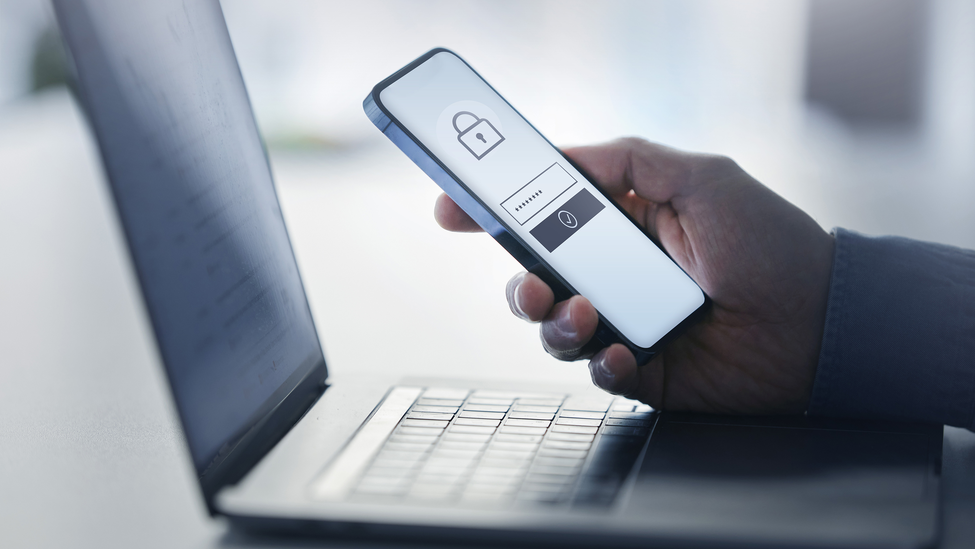5 Cyber Readiness Practices to Boost Your Cyber Security

(SPEECH)
[UPBEAT MUSIC]
(DESCRIPTION)
The Travelers logo with the red umbrella appears. Text, High Five for Cyber Readiness. 1s and 0s fly by inside red exclamation points, which then turn upside-down and crash into a laptop screen, cracking it.
(SPEECH)
Cyberattacks are among the most dangerous risks facing your business today. To help protect your organization from the potential threats that are becoming more common and more sophisticated than ever, Travelers’ cyber experts have identified a handful of practices that, when used collectively, can help achieve a high five for cyber readiness.
(DESCRIPTION)
The screen transforms into a solid white circle with the Travelers logo inside. The circle then becomes the palm of a hand. The five fingers of the hand transform into five vertical capsule shapes. The first one expands into an image of a laptop screen with a lock icon and a smartphone screen with a key icon, each with a password field. Text, 1. ADD MULTIFACTOR AUTHENTICATION.
(SPEECH)
One, add multifactor authentication to your login process. It can help prevent unauthorized access to your systems and accounts, even if passwords are stolen.
(DESCRIPTION)
The password fields turn green and the lock icon unlocks. Another password enters the field on the laptop screen. The screen turns red and the icon locks. The second capsule shape expands into the image of a damaged laptop with a progress bar that reads, UPDATING. Text, 2. UPDATE YOUR SYSTEMS.
(SPEECH)
Two, since hackers often target outdated software and systems, update your systems regularly. Updates often contain important security patches that address known vulnerabilities.
(DESCRIPTION)
As progress ticks along on the progress bar, the laptop begins to repair, cracks disappearing. The progress bar reads, COMPLETE, and the laptop is free of damage. The next capsule expands into the image of the text, EDR, inside a circle. Text, 3. IMPLEMENT ENDPOINT DETECTION AND RESPONSE.
(SPEECH)
Three, implement Endpoint Detection and Response, or EDR, a technology that can identify suspicious activity before the rest of the corporate network is exposed to unnecessary risk.
(DESCRIPTION)
The circle becomes a magnifying glass, passing over a grid of envelope icons. It hovers over two red envelopes with exclamation points on them. The next capture expands into the text, IR PLAN inside a rounded square. Text, 4. HAVE AN INCIDENT RESPONSE PLAN.
(SPEECH)
Four, have an Incident Response, or IR, plan. It should provide a clearly defined and coordinated approach to respond and limit the damage in case you are attacked.
(DESCRIPTION)
The square becomes a checkbox on a checklist, titled IR PLAN, with three items. The last capsule expands into the image of a laptop with scrolling folders on screen. As each folder passes by, a progress bar ticks upward beneath them. Text, 5. REGULARLY BACK UP DATA.
(SPEECH)
And lastly, five, regularly back up data to ensure that critical information is not lost in the event of an incident. Make sure to back up in different secure locations with different media types.
(DESCRIPTION)
A checkmark appears on the laptop screen. The laptop transforms into a lock. Images of a cloud, set of servers, thumb drive and external hard drive appear alongside it.
(SPEECH)
With these five cyber readiness practices, you can prepare to stay ahead of the rapidly changing threat landscape by boosting your level of cybersecurity before, during and after an event.
(DESCRIPTION)
The five capsules join into an upward-pointing arrow that flies up past a vertical progress bar, turning it green. Text, High Five. YOU’RE CYBER READY.
(SPEECH)
High five, you’re cyber ready. To learn more, visit travelers.co.uk/cyber.
(DESCRIPTION)
Text, TRAVELERS, Travelers logo. To learn more, visit: travelers dot C O dot U K slash cyber. The information provided is for general information purposes only. It does not constitute legal or professional advice nor a recommendation to any individual or business of any product or service. Insurance coverage is governed by the actual terms and conditions of insurance as set out in the policy documentation and not by any of the information in this document. Travelers operates through several underwriting entities through the UK and across Europe. Please consult your policy documentation or visit the websites below for full information.
travelers dot C O dot U K. travelers dot I E.
Implementing these Travelers cyber readiness practices can help achieve a high five for cyber readiness in protecting your sensitive data, trust, and operations.
Chris McMurray, managing director for cyber at Travelers Europe, shares five steps businesses can take to strengthen cyber readiness
Cyber threats place organisations of all sizes in the crosshairs of advanced and evolving attacks. PwC’s 2024 Global Digital Trust Insights survey found that the proportion of businesses that have experienced a data breach of more than $1 million has climbed from 27% to 36% in the past year. But such increases are avoidable. More than 30% of the companies surveyed don’t consistently follow standard cyber security practices, so there is ample room for them to strengthen their cyber defence.1
At Travelers, we recommend organisations adopt a series of cyber readiness practices to achieve a “high five” in protecting sensitive data, trust and operations.
Start with an assessment:
- Know your environment. Build and maintain an inventory of all computing equipment (including networking devices) and the software running on them. You can’t protect what you don’t know about.
- Determine how your company identifies, assesses, and mitigates data security and privacy risks.
- Conduct audits or reviews of the company’s data privacy and security measures.
- Interview internal IT professionals (chief data officer, information security officer, privacy officer, data stakeholders, etc.), or those of any third-party vendor that provides IT services, to determine the extent of your system’s data security and privacy protection.
- Identify deficiencies and/or risks and the next steps to promptly correct any issues.
Next, they should adopt these five cyber readiness practices to boost their cybersecurity.
- Implement multifactor authentication (MFA): MFA provides critical protection, particularly in combination with additional security. It should always be in place for all users to help prevent cybercriminals from accessing a business’s system.
- Keep systems updated: An unpatched vulnerability is one of the easiest and most common methods used to compromise a computer system or network. Enable automatic updates where possible, replace unsupported systems, and test and deploy available patches quickly.
- Use endpoint detection and response (EDR): An EDR solution protects against malicious attacks, providing a much stronger shield than a traditional antivirus solution. It can identify suspicious activity within the network before the rest of the network is exposed.
- Have an incident response plan: A clearly defined, focused, and coordinated approach to responding to cyber incidents can limit damage and hasten a return to normal. It also shows partners, suppliers and clients that you take cybersecurity seriously.
- Back up your data: Make copies of important data and system configurations and protect them. Data can include protected health information, payment information, personally identifiable information, intellectual property or other proprietary information. A best practice is to create one primary backup and two copies of the data, save these backups to two different types of media, then keep at least one backup file off-site and offline.
These steps, together with cyber insurance that offers pre and post cyber breach services, can help a business better anticipate, withstand, and recover from a cyber event.
Visit travelers.co.uk/cyber or contact us to learn more about CyberRisk coverage and our services for you and your clients.
The information provided in this article is for general information purposes only. It does not constitute legal or professional advice nor a recommendation to any individual or business of any product or service.


